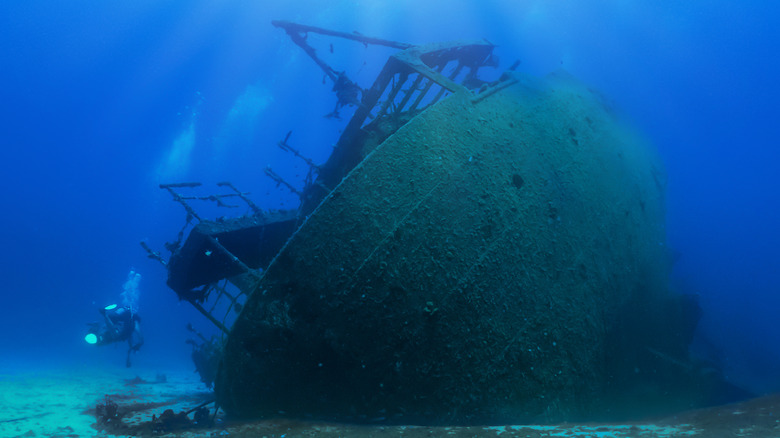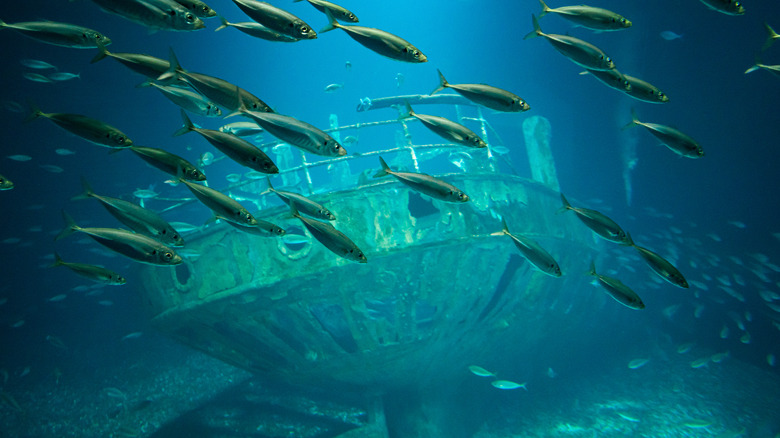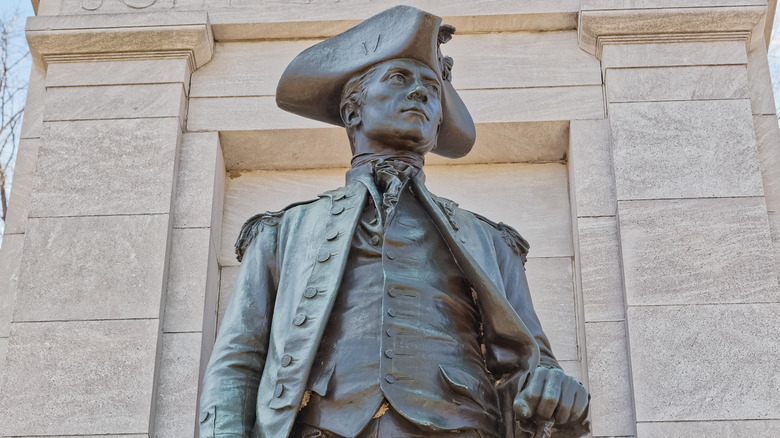The Tragic Sinking Of The Bonhomme Richard Explained
When Captain John Paul Jones and his crew set sail from France in 1779, along with four ships from the United States, they could have never known the harrowing journey they were embarking upon. After a few days at sea, they would find themselves in a deadly battle with their British enemies.
September 23, 1779, was the fateful day for the Bonhomme Richard, a U.S. warship (or frigate). Along their journey, the ship crossed paths with the Serapis and Countess of Scarborough, two armed vessels looking for a fight, according to History Collection. In the Battle of Flamborough Head, the opposing sides dueled for nearly four hours.
The Serapis was on its maiden voyage, and its main mission was to protect merchant ships from pirates, according to the National Museum of American History. The Bonhomme Richard set sail with other ships — the USS Alliance, Pallas, Vengeance, and Cerf. Their travels were uneventful until that night, when, at around 6:00 p.m., the British ship, Serapis, challenged the Bonhomme Richard (via History Collection).
The story behind a U.S. Naval hero
John Paul Jones was an experienced captain. He signed up for a seven-year sailor's apprenticeship when he was just 13 years old, learning navigation skills as he grew more experienced (via the John Paul Jones Museum). Jones worked briefly on merchant and slave-trading ships, but as the John Paul Jones Museum describes, "He quitted the slave traffic in disgust calling it an 'abominable trade.'" He was known to have violent outbursts, and Jones fled the West Indies after killing a man in 1773, changing his name to avoid detection.
Despite this background, Jones had garnered acclaim for his leadership on a ship where the captain and other top-ranking sailors died of yellow fever, according to the John Paul Jones Museum. Now considered as one of the Fathers of the U.S. Navy, Jones was assigned to lead the Bonhomme Richard during the American War of Independence.
Captain Jones led one of the first first ships in the Colonial Navy, during the Revolutionary War, per BBC. In the late 1770s, Jones went on several destructive raids; he and his crew would stop in a town, loot and pillage the most valuable properties, then board the ship to make their getaway (via the John Paul Jones Museum).
That's why the Serapis and Countess of Scarborough, who were patrolling the seas for pirates, first made contact with Jones — because there was an entire squadron that was already looking for the Bonhomme Richard.
A fight for the ages
The Serapis had more firepower than the Bonhomme Richard. As the crew fought, it became clear that the British ship, loaded with dozens of built-in guns, was winning. The Serapis fired on the American ship Bonhomme Richard, badly damaging it. Jones was undeterred. In one famous exchange, the commander of the Serapis, Captain Richard Pearson, asked him if he wanted to surrender. Per USNI News, Jones replied, "I have not yet begun to fight!"
Jones tied the two ships together so that the Serapis couldn't steer away (via The National Museum of American History). Another ship joined Jones in the fight, allowing him to cut holes for more guns in the gun deck to escalate the battle even further. Pearson finally surrendered after being outnumbered, but the damage to Jones' ship, the Bonhomme Richard, was brutal.
For the next 36 hours, Jones and his crew frantically tried to make repairs (via History Collection). Jones decided to take over the Serapis — there was very little of his own ship that could be salvaged. According to the National Museum of the U.S. Navy, despite their best efforts, the Bonhomme Richard sank just hours later.
Although the Bonhomme Richard had more sailors on board, each ship lost more than half of its crew members in the fight, and many who survived were badly burned. Jones took more than 500 Serapis and Countess of Scarborough crew members as prisoners, reports the John Paul Jones Museum.
Mysteriously disappeared for hundreds of years
The ship was lost in the depths of the ocean for hundreds of years and is believed to have only recently been recovered, as reported by USNI News. Many teams searched for the wreckage with little success. The U.S. Navy tried to find the ship while they filmed the "Mighty Ships" series for the Discovery Channel, and came up empty-handed, according to History Collection.
In 2017, a team located remnants of the Bonhomme Richard along the British coastline in Yorkshire, per War History Online. They searched in torpedo alley, a spot known to house countless shipwrecks. They discovered an anchor, a bell, rigging materials, and beams that dated back to the 1700s, which strongly suggested it could be the Bonhomme Richard. Using X-rays and satellite images along with the physical evidence, experts now agree it's likely that the historical ship has been recovered at last.



